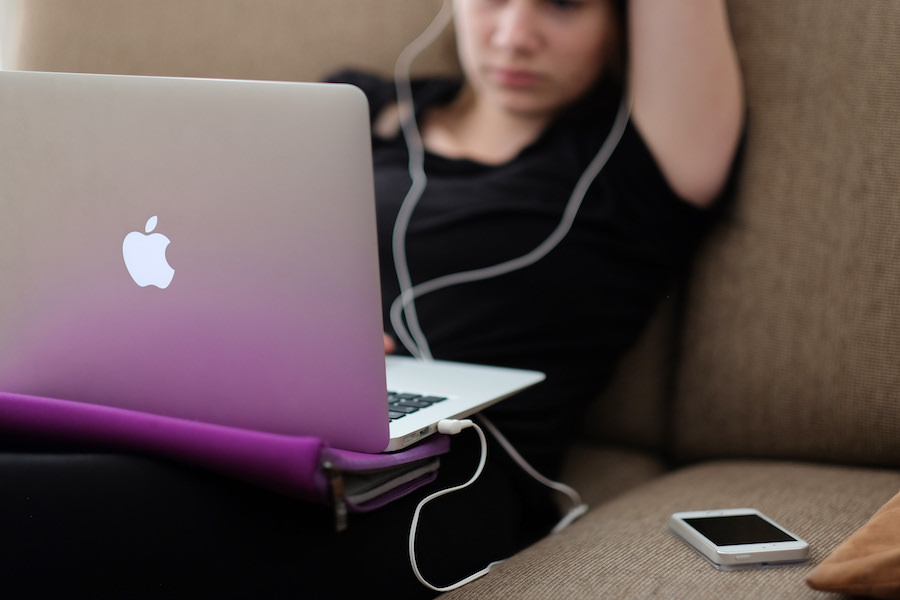
Sarah K. Stephens
Contributor
I am a mother of 3 teenagers, which means my household is bustling with lots of energy. I joke with my family that each day is literally a foray into the Game of Hormones, full of intrigue, heartache, and a quest for (intrafamilial) power.
Pubertal puns aside, though, my role as a caregiver has shifted significantly since my children embarked into adolescence.
When my children were smaller, I knew almost everything about the goings-on of their lives because I was present for the majority of those events, and sometimes that level of intimacy was overwhelming (cue me silently reciting: I just need some spaaaaaaace!).
Now, I find myself begging for glimpses into their lives. Sure, our family strives for open communication and we spend a good deal of time enjoying each other’s company, but our children are teenagers, with their own circle of friends and extracurricular experiences my husband and I are often not privy to.
And then there is the entire phenomenon of each child’s ‘digital self’ to try and keep track of, including their emails, social media presence, and texting relationships.

Photograph via Steinar La Engeland
As a developmental psychologist, I am barraged by information in my field regarding (primarily) the perils of the online world for children. Sexting, cyberbullying, and obesity, just to name a few. It’s enough to induce a tension headache in any parent, and the sheer magnitude of our children’s online selves can encourage us to disengage from the issue altogether. Blissful denial, anyone? I know I’ve felt that way.
For instance, as a parent I’ve had great difficulty tracking the different platforms my children might be engaging in online. Just when I thought I had clear ground rules laid down for Facebook, along comes Twitter. And Snapchat. And Instagram. And Wattpad. And. . .
That pause there? That was me, searching the Internet frantically to see what else my children might be getting into online.
You might be asking: Why don’t you just monitor your children’s online activity and use filters for content?
This question seems to underscore a simple solution embedded in basic parenting techniques—just keep your eye on what they are doing–but is in truth fundamentally difficult. Or, at least, difficult for me. And tons of other parents, I’d venture to guess. It is fundamentally difficult for two reasons, one being logistical and the other being socioemotional.
Logistically, many families across a wide spectrum of socioeconomic statuses now have access to high speed internet in their home. Many households, though fewer than those with solely broadband access, have multiple devices that are capable of going online.
When school-provided computers are also brought home, such as in my children’s school district, the number of devices available for perusing the internet only expands. Although our family has one desktop computer, located in the central part of our home in a public area, our children each have their own laptop provided by the schools.
Photograph via Steinar La Engeland

Our children also, through a combination of saved allowances and birthday and holiday gifts, have accrued iPods, Kindles, and a laptop (for our teenage son). Although my husband and I have placed parental restrictions on our home computer and our children’s home devices, we have no control over the filtering of the school-provided computers, which means our children can access content and apps deemed appropriate by the school, but perhaps not appropriate by myself and my husband.
As an example, we have Youtube blocked on our home computer because we found our children were using it primarily to look up humor videos related to bodily functions or what we’ve come to call “make-out videos” (which are basically highlight footage of make-out clips from popular TV series for teens).
Arguably not the ideal way for our children to spend their time when they have homework in the queue. These videos aren’t porn or even ‘mature’ in their rating, though, so they come through the school filter as ‘appropriate.’
Similarly, have you ever tried monitoring your children’s activity online via multiple different devices and portals? Not to mention that, even if you’ve had regular family meetings about social media usage and developed a rule of not opening a social media account unless it is approved first by the parents, you are still likely to encounter situations where your child has signed up for an account on Twitter or Instagram without your permission nor knowledge.
Think googling your children’s names or searching the social media apps for their names will help you locate them? Not likely—because children don’t use their real names in social media, but rather nicknames, avatars, and, in the case of our kids, their favorite Glee characters’ names.
Which brings us to the socioemotional issue: Should you spy on your children (i.e., read their e-mails, texts, etc.)?
When my children were younger, my overwhelming answer was, “Yes!” Because young children have limited executive functioning abilities (e.g., inhibitory control, understanding long-term consequences of actions, future planning).
But now that my children are in their teens, and one of them is set to leave for college in less than 2 years, I’ve realized that I can’t rely on my monitoring skills to keep my children safe from the ills of the online world. I’ve got to begin to trust them to make good decisions—and more importantly, to learn from their bad decisions.
Mainly, I want my teenage children to tell me about their lives. At this point in our family’s life, though, I’ve found that confronting my children with content they’ve hidden from me and I’ve subsequently discovered by secretly peeking in on their online worlds backfires—it seems to promote less openness with me in the first place and encourages them to lie better about sensitive topics that are already icky to talk about with your parents (you know, like sex, substance use, and overall risk-taking behaviors—yeah, those heavy hitters).
I’m a behaviorist by training, which means that I focus on patterns of reinforcement and punishment in assessing human behavior, including my children’s.
What I’ve come to determine is that, although monitoring my children’s online activities can create opportunities for punishing inappropriate behavior or dishonesty, it rarely creates opportunities for powerful reinforcement of appropriate behaviors and decision-making. And as any behaviorist will tell you, reinforcement is much more successful in motivating appropriate behavior than punishment.
When I have an opportunity to ask my children pointed, but hopefully encouraging, questions about their online usage, I also have the opportunity to reward them with praise, smiles, attention, hugs, and the like when they choose to open up to me about their online worlds. Will they potentially lie to me still? Of course!
But, if I continue to reward disclosures of their online lives, behavioral law dictates that my children will open up more and more over time, which is exactly what we all want, right? That is, access into our children’s lives so we can make sure they are safe, happy, and healthy.
Photograph via Steinar La Engeland

That said, even with teenage children we continue to use certain strictures in our home to keep the totally nasty aspects of the internet out of bounds for our children. Below is a list of tips, from my family to yours, based on academic research and recommendations from governmental agencies devoted to the online protection of children and families.
1. Keep computer usage restricted to public areas of the home. If your child is an older teen, require that the door remain open while using the computer in their room. This will likely deter the accessing of illicit materials, off-task behavior instead of homework completion, and reduces the sense of anonymity children might feel when posting publicly on social media (i.e., will encourage kinder behavior online).
2. Store all devices in the parental bedroom at night. Devices should not be stored in children’s bedrooms, including teens, because of issues with behavioral inhibition and the importance of sleep at this stage of development (i.e., childhood and adolescence).
3. Set parental controls on all mobile devices. Most devices include a site devoted entirely to instructions on this process.
4. Use a passcode on your own phone and devices, so your children won’t use it to access illicit content when it’s just lying around your home and you are nowhere to be seen.
5. Remember that many videogame consoles access the internet, included PS4 and the WiiU, and that each system offers parental control restrictions for internet usage. These do not come employed by default, though, and you need to actively set them up yourself as the caregiver. The same goes for ‘smart’ TVs.
6. The most effective filter we have found for our home computer is surprisingly free, but works incredibly well and offers a variety of personalized settings, including time restrictions and specific website blocks beyond broad categories: K9WebProtection. I highly recommend it. Even if you have very young children who aren’t interested in sex, drugs, and rock-n-roll yet, put it (or some other filter) on your computer. The majority of pornography exposure that occurs for young children is accidental, and often a result of searching for relevant and appropriate material online.
More About Sarah K. Stephens: Sarah K. Stephens earned her Doctorate in Developmental Psychology and teaches a variety of human development courses as a lecturer at Penn State University. Although Fall and Spring find her in the classroom, she remains a writer year-round. Her short stories have appeared in Five on the Fifth, The Voices Project, The Indianola Review, and the Manawaker Studio’s Flash Fiction Podcast. Her debut novel, A Flash of Red, will be released in Winter 2016 by Pandamoon Publishing. Follow her on Twitter or Facebook and read more of her writing on her blog.






